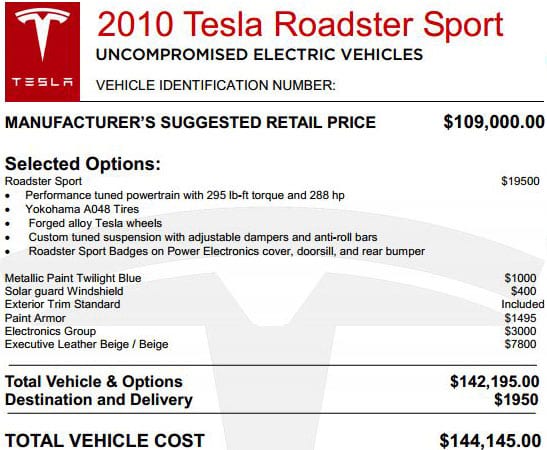Roadster Valuation 2017 October 23, 2017
 The number of Roadsters for sale seems to be increasing. With more cars available, cars sit longer waiting for buyers, and prices are declining. Supply is up, demand is down, and this may be why:
The number of Roadsters for sale seems to be increasing. With more cars available, cars sit longer waiting for buyers, and prices are declining. Supply is up, demand is down, and this may be why:
The Lithium Ion cells in a ESS Battery Packs are End of Life (EOL). Let’s not forget Tesla originally projected a 10 year ESS Pack service life. Roadsters have been on the road going on ten years, and all will soon need ESS Packs upgraded or replaced to keep cars on the road. Companies like Gruber Motor are able to recover bricked packs, but cannot extend the service life of a pack.
Power Electronic Modules (PEMS), the heart of the Roadster propulsion system, contain certain aging components that are also going EOL and need to be replaced. A PEM upgrade is not optional and a great time to resolve known engineering problems.

Tesla Service Centers are rapidly expanding to meet the needs of the growing population of newer Tesla cars. Roadster service skills at the SC’s continues to decline. Some Roadster parts are no longer in production, and wait times for
repairs are getting longer. Third party maintenance, which will eventually take over Roadster support, is still in its infancy, hampered by zero support from Tesla, access to schematics, tech support, or any sort of factory training programs, free or paid.
Let’s do the math. Roadsters are currently selling around $45K – $65K with original ESS packs. This price is undoubtedly
factoring in an unavoidable future 3.0 ESS battery upgrade and replacement for $30K. A recent sale of a 2010 R80 Roadster with only 2000 miles on the odometer, which was upgraded with a 3.0 Pack just before sale, sold for only $75K..
Current cost of PEMs with labor is around $10K. PEM repairs and upgrades are not for the faint of heart. A botched home repair can result in a damaged board, and since Tesla considers internals unavailable for sale, the fallback is $10K. PEMs are currently out of production and rebuildable cores may be running low. Some Roadsters parts are already unavailable.
The new Roadster announcement may also have a dampening effect on first generation vehicle sales. The promise of new technology, even more impressive performance specs, new warranties and renewed parts support, are tough competition.
Few doubt the original Roadster will someday be collectible. It has earned a place in history as the genesis of a disruptive new transportation technology and concept. As with any future collectible, the issue is when, and there is no reliable timetable.
Some early Ferraris took decades to become interesting to collectors. Sixties muscle cars were crushed by the tens of thousands as unpopular gas guzzlers, only to re-emerge as boomers decided they wanted their Highschool cars. The much larger demographic spawned a number of after market parts suppliers which supported restoration efforts.
Muscle cars are also comparatively low tech. A backyard mechanic usually took on a fun restoration project as a hobby, able to handle key aspects of a restoration including various upgrades and replacement such as brakes, interior, suspension, wheels and tires, exhaust, farming out more daunting items like paint and body work, re-upholstery, and engine rebuilds.
A used Roadster purchase rarely requires paint and body upgrades since few are daily drivers and usually garage queens. Due to technical complexities, repairs or upgrades to the primary propulsion system, the PEM and ESS Battery Pack, are out of reach for the majority of owners. A roadster purchase does not meet the requirements of a fun backyard restoration project.
Internal Combustion Engine cars sit and age reasonably well. Occasional use keeps fluids circulating, gaskets may dry out, carburetors gum up, but overall, deterioration is minimal, manageable, and usually owner performed. A sitting Roadster deteriorates whether in use or not. The batteries and electronics have a closely related service and shelf life.
A first generation Roadster buyer needs to be someone comfortable with the prospects of living with and maintaining outdated technology which may go EOL, increasing parts shortages, dwindling service support, and lots of patience.
Roadster Charge Port Care
The Roadster charge port is a high current connecting point which periodically requires cleaning and lubrication. Deoxit Spray Contact Cleaner cleans and chemically improves conductivity, deoxidizes, reduces wear and abrasion.
Both Socket & charge cable plug need this maintenance. Use compressed air and Q-Tips to clean out recessed areas after spraying on Deoxit, and finish the job by applying a Teflon lubricant like a McLube product.












